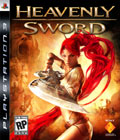Ninja Theory's Heavenly Sword was much anticipated and therefore much hyped, but what, really, is this game in the scheme of early PlayStation 3 titles? Lair was the console show-off, delayed, delayed again, always planned as braggart for the PS3's graphics and audio capabilities, and the usefulness of the SixAxis controller's motion-sensing feature. Did I mention Lair was delayed? But still, the game was expected on eventual arrival as a stereotypical high school cheerleader: cute as button, adorable in all aspects, but lacking much depth. And that it was, although it's not nearly as guilty of the crimes of which it's been accused, as it well succeeds at what it is — a show-off! — while being at least a bit of fun to play. Then there's Killzone 2, PS3's Halo in spirit, if not in design. But Killzone 2 remains a distant dream, so that brings us back to Heavenly Sword, which was the PS3's best early hope for a stand-out title. Heavenly Sword would not only show off the technical prowess of the PS3 but also possess great gameplay. She'd be pretty and smart!
Without gilding the lily, I have to report the game is a button-masher. If you don't figure this out in the first few minutes of play, before long a tutorial hint pops up on screen, informing you that when protagonist Nariko is felled by enemies she will recover more quickly if you "mash buttons." There we go: due diligence, no obstruction. Not even Ninja Theory tries to hide it. If you want to write this game off as a button-masher, stop here and don't waste your time reading the foregoing; but before you leave, I'll remind you that the first true whopping success of a video game involving any kind of real, ahem, combat was a button-masher. One button. Not so much mashed as repeatedly smacked into submission. That's right: Space Invaders. The halls of classic game libraries are filled with button-mashers, some of them still enjoyed and much-praised today. There's no shame in button-mashing. It's a gameplay mechanism, but it's so distinctive it's really an entire genre. There's no accounting for personal taste, but button-mashing in and of itself does not a bit to detract from the quality of a game.
Based on all the wild build-up for this title, I had no idea what to expect of Heavenly Sword other than it would have great graphics. It does. Have great graphics, that is — probably all-around the best graphics on any PS3 title to date. It's gorgeous, but there's a lot more here. Indeed, in the first hour or so of play, I couldn't see how I could avoid assigning Heavenly Sword a score of 10. A 10? I just couldn't do that, could I? A 10 is perfect. A 10 is sublime. A 10 doesn't really exist, does it? Tens are virtually impossible to justify in game criticism; that's why you see so many 9.8s and 9.9s assigned to superior titles.
Heavenly Sword is a single-player campaign with no online element whatsoever. No leaderboards, nothing. Overall, this was a good decision, as it allowed Ninja Theory to concentrate on what was intended: a great single-player game. The plot revolves around, you wouldn't figure, a blessed or divine sword, and the female lead character, the aforementioned Nariko, is charged with protecting it. It's a stock-and-trade fantasy plot, familiar to anyone who's ever read any kind of fantastical novel or seen such a film. There's the holy relic, our hero the holy relic's keeper, the hero's mentor — Nariko's father, Shen, de facto leader of a loose affiliation of disparate but peaceful peoples — Kai, the childlike — or idiot savant, pick your term — ingénue in need as much as the relic of our hero's protection, the bad guy who desires sole possession of the relic — enter King Bohan — leading a formidable army obliged to get him what he wants and, last but hardly least, a whole host of subordinate bad guys serving the chief bad guy as means for accomplishing their own agendas.
I was delighted by the story because I had my first knock off the perfect 10: trite plot. Ah, not so fast. The Christ story has become trite in fiction but still permeates innumerable stories, both good and bad. Sometimes it seems like all stories are Christ stories. (Okay, "Bridget Jones's Diary" is not a Christ story, except Bridget's boyfriend: He has Christ-like traits, does he not?) I had my holy relic, the Score Axe, and then went and lost it. I can't fault Ninja Theory for taken a proven, if well-worn, plot-line and perfectly executing it. And it is perfect. The dialogue is outstanding, and the voice acting is superb. Both of the animated scenes through which the plot unfolds and the interstitial cut scenes driving the plot forward are not cinematic; they are cinema. Spot-on, deftly directed, beautifully rendered, they are as fun to watch as the game is to play. You can skip the longer scenes with the SixAxis' start button — although you cannot do likewise with the interstitial bits — but you shouldn't, and you probably won't. Icing on the cake, the musical score is well written and suits both the non-interactive scenes and the game missions.
There are two unique subtexts running through the plot. During a couple of very subtle intimations, it's difficult to tell if the relationship between Nariko and Kai is that of mother and daughter or senior and junior siblings, or if, perhaps, it is a homosexual love affair, although obviously unconsummated. Sparing the risk of introducing another character into the plot, one I'd name He Whom Nabokov Called The Viennese Witch Doctor, I won't speculate further along this track. The second subtext, however, suspiciously lurks early on and is almost outright confirmed later in the game with dialogue spoken by King Bohan: Heavenly Sword is a commentary on Western colonial invasion of the East, the Orient. Despite the blatant Asiatic features of the good guys and the Northern European appearance of the bad guys, it's still subtly delivered, and should you abhor a little morality delivered with your video games, it won't trouble you. But it's there, and it's real.
If it's not clear by now that Heavenly Sword's graphics, character models and animations are stellar, I can't help you. In the audio category, music is, again, well done and the sound effects appropriate and effective, all making good use of digital surround-sound systems. There is a point late in the game, however, where the roaring din of Bohan's massive attacking army, the firing of catapults, attendant explosions and the various clings and clangs of Nariko's swordplay overload the specialized parts of the game's software handling sound, causing in one or two spots the digital sound stream to stutter or crackle with brief static. This technical problem doesn't detract from the game, but you'll likely notice. Don't check your speaker connections: It's just the game.
Since Heavenly Sword is admittedly a button-masher, there's little point in discussing at length the intricacies of mashing those buttons. Suffice to say, you mash the buttons in different sequential combinations to make Nariko perform various blocks, attacks and special attacks, resulting in varying amounts of carnage, from pedestrian knock-downs to eye-poppingly impressive battlefield executions. As the game progresses, the better you perform, the more Nariko's skill improves, in line with the increasing difficulty of your enemies — matters stay well balanced throughout. Solid performance is also rewarded by unlocking special features of the usual concept art and behind-the-scenes variety.
Sprinkled throughout Heavenly Sword, there are a few negotiations of route and access that vaguely qualify as puzzles. They're all easy, and Ninja Theory provides visual cues for how to proceed. This is as it should be; the game is a straight-up action/adventure with filmic qualities; it's a button-masher, not a head-basher.
Of special note is the use of SixAxis motion control in the title. In all of Kai's missions, she employs a bizarre contraption of a weapon — something on the order of a crossbow married to a Colt revolver — and when Nariko fires cannons, launches rockets (Yes! There's a rocket launcher in this low-tech world!) and throws objects, you're required for maximum damage to use the game's rather meaninglessly named "aftertouch" feature to guide projectiles to their targets from an immediately aft perspective. As usual, as absolutely required in PS3 titles, you have the option of turning off the SixAxis motion control and using instead the analog sticks. That was certainly the first thing I did. But don't you dare. Heavenly Sword possesses the best implementation of SixAxis motion control yet. I switched back to motion control after one go with the analog sticks. The in-flight control takes a brief bit of getting used to, as your movements are not turn-on-a-dime accurate, but this is a function of the game's design — these are quarter-ton cannonballs you're manipulating, not wire-guided missiles — not a failing of the SixAxis. Heavenly Sword proves SixAxis motion control can be integrated into a game without overwhelming the control scheme.
So we have a 10, right? The first perfect game for the PlayStation 3? Oh, would that it were. The game progresses through a series of missions, most belonging to Nariko, a few for Kai, ramping up the difficulty all along, chapters culminating in venerable, accustomed "boss battles." Eventually, you'll have to repeat some of the missions, either because you didn't quite get the trick of defeating new enemies on the first go or you just flat made a catastrophic mistake. For example, you — that's you, mind you, not me — accidentally straightaway kill the bad guy from whom you're supposed to extract some important information. Fortunately, for the most part, the chewy bits are unique and fun to play; you won't mind repeating the brief missions once or twice. In the latter third of the game, though, there is at least one — some players will claim another — boss battle you may repeat to the point it becomes what is known in the vernacular as "a grind." These complaints are hair-splitting because you will get through them in good time. Take a break and come back a little later. Everything works out.
What blows Heavenly Sword off its precarious chance at a perfect score is the final boss battle, the defeat of King Bohan. Once you discover the trick to it, a process requiring a few repeats, it's not at all hard; it's just long, long, long, interminable even, and what's worse, it's senseless. By this point, Nariko and her divine saber are so powerful they are just not of this earth, or not of whatever earth Heavenly Sword occupies. She's omnipotent. Thus Ninja Theory had a valid out: let us drop-kick King Bohan in the face and be done with it. Making matters even worse, earlier in the game, the developers exhibited the design acumen to do just that. Without giving away too much, there's a difficult mission in the latter part of the game you think you'll never beat. You just can't get the trick, if there is indeed a trick at all; you'll never make it, and you're about to die again with absolutely no possibility ... and then they just let you out. Walk away, you win. It's a conceit but comes as a complete surprise and fabulously welcome. At the end of the game, Ninja Theory should have repeated something themselves, recycling that same game-development sleight of hand to wrap up everything. This wouldn't have disappointed few, if any. As it stands, the final mission tacks on at the very last moment to a near-perfect game a long, slow-moving queue at the post office.
 You have a couple of options here, unless you're a completist, in which case you have no choice but to sally forth. For everyone else, you can keep at it, pick it up and put it down until you finish the last mission. Or you can just quit. Stop the madness. The game is over, anyway. You'll miss out on the final loose-end-tying cut scene and the hell-mode option unlocked by winning the game — but, typically, when I see the phrase "hell mode" in a video game, I turn around and walk the other way.
You have a couple of options here, unless you're a completist, in which case you have no choice but to sally forth. For everyone else, you can keep at it, pick it up and put it down until you finish the last mission. Or you can just quit. Stop the madness. The game is over, anyway. You'll miss out on the final loose-end-tying cut scene and the hell-mode option unlocked by winning the game — but, typically, when I see the phrase "hell mode" in a video game, I turn around and walk the other way.
Save the terminal crash-landing, Heavenly Sword is a superb game that exceeds any and all expectations. The title is by far the best single-player experience yet on the PlayStation 3 and certainly one of the finest on any platform this year. To quote General Flying Fox, King Bohan's most wicked, self-absorbed henchman, as just a bit too late, he realizes his jig is up, "Style ... That had style."
Score: 9.4/10
More articles about Heavenly Sword












 A dramatic tale of revenge sees Nariko, a fiery red-haired heroine embark on a quest for vengeance against an invading King and his army.
A dramatic tale of revenge sees Nariko, a fiery red-haired heroine embark on a quest for vengeance against an invading King and his army.
























